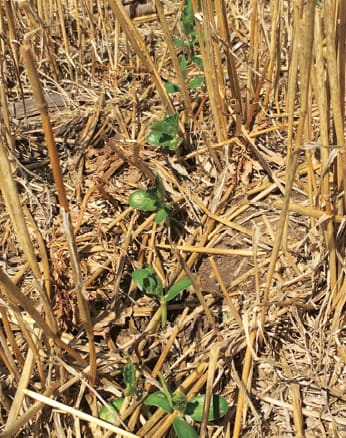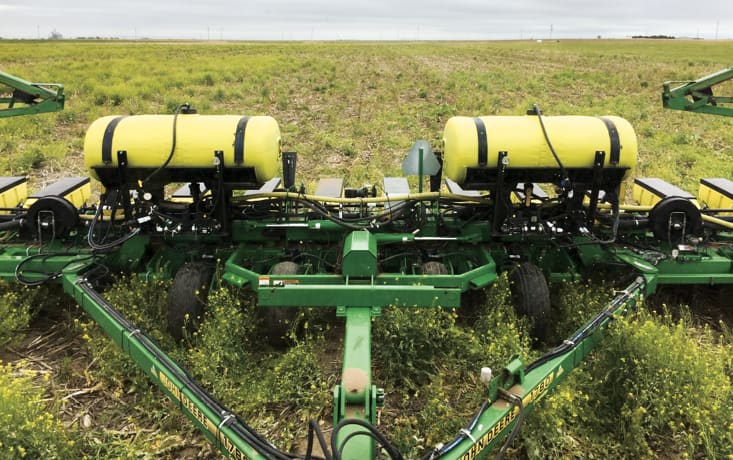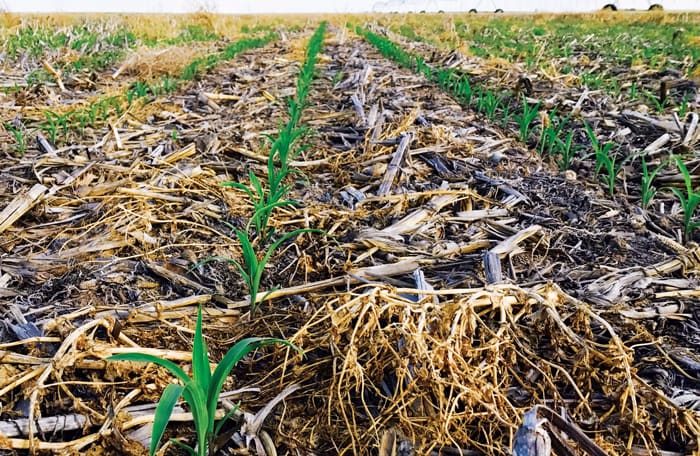When Nick Vos came from South Africa to the U.S. to farm, the transition wasn’t an easy one.
He grew up on a vegetable farm in the Limpopo Province of South Africa, North of Johannesburg. Their family lost everything in 2000 during a massive flood following 23 inches of rain falling in just over one week.
Every bridge along a 168-mile-long river in his area were taken out and the Vos family’s crops were without power for over 2 months. What didn’t flood, dried out and died.
Vos had the opportunity to move to the U.S. as a green card holder in 2006 and began farming with another enterprise. Vos’ family became U.S. citizens 5 years later.
In 2014, Vos started to farm on his own, no-tilling dryland and irrigated crops and raising sheep near Hugoton in southwestern Kansas. That same year he also started Prairie Seeds, selling seed corn and cover crop seed.
Smarter Seeding, Fertility
Vos farms about 1,000 acres, 300 irrigated and 700 dryland, no-tilling all corn, soybeans, milo and wheat where possible, as well as oats for hay. His wife Johanna started incorporating Dorper sheep into the operation 3 years ago.
After starting out with strip-till in 2014, Vos has gone to 100% no-till on the vast majority of acres and says he’s addressed erosion and nutrient issues and seeing some relief in irrigation costs.
Vos estimates no-till saves him an average of 4 inches per year in water needed for his irrigated crops, a savings of $40 an acre. This is key in a semi-arid climate. As of March 16, Vos’ area had gone 160 days without any measurable precipitation.
“We’re doing tissue sampling continuously and we’re not deficient in phosphorus yet. The soil biology seems to work for us.”— Nick Vos
For planting milo and corn, Vos uses a John Deere 1780 23/15 split planter, with a wavy coulter, no row cleaners and steel closing wheels. The machine has a Shield Ag/Acra-Plant system and Raven 4400 rate controller to apply fertilizer in furrow with the 12-row planter.
His 15-foot CrustBuster drill, set to 10-inch spacings, has Schaffert Mfg. fertilizer tubes and a Raven controller.
With those tools at hand, here are some keys Vos shared at the No-till on the Plains Winter Conference about how he no-tills crops in a semi-arid region:
-
Know it Cold. One of the keys to making corn work, Vos says, is knowing the cold germination score of corn seed. He often plants in April when soils are 50-55 F, not 70 F, which is usually what the germ rate on the bag is measured at.
Since working with AgVenture, Vos likes to plant corn deeper — 2-3 inches — to promote maximum root structure and allow plants to have five sets of nodal roots. Planting corn less than 2 inches could reduce the chance of forming the fifth set, reducing root systems by 20-30%, he says.
“This does not help the corn in stress times,” Vos says, noting that he learned about the root-structure issue from a friend, Glen Long.
Vos plants soybeans about 2-2 ½ inches deep, about 1-1½ inches deeper than the norm.
-
Split it Up. Given the volatile weather conditions in his area and the low organic matter in his soils, Vos feels it’s best to use multiple applications of nitrogen (N) rather than applying it all at once like many of his fellow farmers do.
“We advise people never put all your eggs in one basket with N. Then if you get a hailstorm, you don’t have a lot of inputs in there,” he says.
Vos says fertigating corn through pivot irrigation is important, but he also applies 2½ gallons of 10-34-0 starter fertilizer in-furrow, blended with Royal Grow’s Enzyme Max and Micro Pack, noting that it’s important to put a carbon source with the fertilizer. That’s followed later with a foliar application of Micro Pack that includes manganese with his post-emergence herbicide application.
“For corn we do tissue sampling at V5, V10 and at tassel, trying to correct any deficiencies at V5, V10 with foliar products. At tassel we mostly check to get an idea of the fruit set and where we’re going to be next year,” he says. “What did we miss? If we miss something we can’t usually correct it at tassel, but it gives us an idea for next year on what we need to do.”
Vos consults with his nephew Willem Pretorius, an agronomist in Goodwell, Okla., on the tissue test results as well.
He follows a similar program for double-crop soybeans, aiming to apply 1 pound of phosphorus (P) for every 1 bushel of soybeans anticipated. He is hoping to use less as his soil’s biology increases.
Vos also double-inoculates soybeans, especially in soils where he’s never planted the crop before, utilizing a seed treatment and then applying a dry product at planting. He says trials on his farm have shown the program works just as well or better than university-recommended practices of applying N through a pivot.
He rarely adds extra N to the soybean crop unless he expects yields of 80 bushels or more. Even then he still prefers a foliar instead.
-
Narrower Beans. Early on, they strip-tilled soybeans in 30-inch rows. He didn’t feel humidity levels in the canopy were high enough, so he started doing trials with soybeans drilled in 10-inch spacing and they out-yielded beans in 30-inch rows right away, he says.

10-INCH BEAN ROWS. Nick Vos likes to no-till soybeans in 10-inch rows at 2-2½ inches deep, about 1-1½ inches deeper than the norm. This improves stands in his semi-arid climate. For double-crop soybeans, he aims to apply 1 pound of phosphorus for every bushel of anticipated soybeans.
“I can honestly say that in my area, 10-inch beans have become the norm,” Vos says. “We’re so dry and arid that in 30-inch beans you’ve got too much airflow through the canopy. With 10-inch beans you stop the airflow, you create a little greenhouse effect and it adds yield.” -
Low-Budget Wheat. Vos says he’s been farming in the U.S. for more than a decade and winter wheat has yet to be a dependable crop, but it’s still important to his rotation.
“We spend as little money as possible on wheat and wait and see what happens,” he says. “It’s an excellent cover crop and weed suppressor. A lot of guys use wheat over the winter to cover their fields.”
For the last 5 years Vos has been including about 2 pounds of Daikon radish for every acre of seeded wheat, and clover has been added recently. While he hasn’t seen much of a yield bump, Vos feels his own trials show wheat handles drought and heat stress way better when cover crops are present.
While milo is a good high-carbon crop and can be useful for grazing stockers and increasingly cow-calf pairs, Vos says he’s struggled with controlling Palmer amaranth, bindweed and grass weeds in the crop. It also doesn’t handle high-pH soils well.
Challenging for Covers
Vos started seeding cover crops in 2010 when he was still part of the other farming operation. He’s continued working with covers since then. His main opportunities to seed covers are behind winter wheat, flying them on into standing corn, drilled in before or after corn or soybeans, or drilled after milo for grazing.
Vos has embraced Daikon radish for its ability to scavenge nutrients in his sandy, low organic-matter fields. He notes that it has produced good results on his farm because they help neutralize his high-pH caliche soils. Caliche soils are layer-like accumulations of calcium carbonate.
Brassicas like mustards, radishes, broccoli and kale don’t associate with mycorrhizae, but use acids to get minerals for themselves, rhizosphere ecologist Jill Clapperton has said. The acid exudates free up P being tied up by calcium and help in mineralizing bound-up P.
Brassicas also stimulate the middle of the food web that includes mites, earthworms and other recyclers that prey on bacteria and fungi.

ABSENCE OF WEEDS. Nick Vos uses a John Deere 1780 23/15 split planter with wavy coulters, no row cleaners and steel closing wheels to no-till corn and milo, along with a Shield Ag/Acra-Plant system and Raven 4400 rate controller to apply fertilizer in furrow. During this May corn planting, Vos notes the lack of pigweeds and kochia due to cover crops over winter.
Vos considers the “most valuable cover” on his farm to be millets, brassicas and summer legumes drilled in after winter wheat harvest. The mix is best suited for sandy, irrigated fields.
“When you take a pH from 8.8 down to 7.5 or 7, the root zone will have a lot more nutrients available for the next crop. That’s why we’ve been seeing the yield bump we’re getting with corn,” Vos says.
“We have not put phosphorus in our corn field 2 years in a row now, this year will be the third. The only phosphorus goes with the starter in the root zone with 10-34-0. We are doing tissue sampling continuously and we’re not deficient in phosphorus yet. The soil biology seems to work for us.”
Related Content
- No-Till, Covers and Livestock Tame Volatile Weather Challenges: Howling winds, dryness and poor soil quality create tough conditions, but Egon Zunckel is making no-till work with limited irrigation, cover crops and livestock.
- Making Cover Crops Work in Semi-Arid Environments: In 2019, most growers dealt with too much rain. Yet, there are areas and years when getting a cover crop established and reaping the benefit without draining soil moisture is a challenge.
- Building a New Path to Dryland No-Till Prosperity: After eliminating fallow more than a decade ago, Colorado no-tillers Scott and Lyle Ravenkamp are using cover crops, compost fertilizer and residue-conscious equipment to get the most from their dryland operation.






Post a comment
Report Abusive Comment